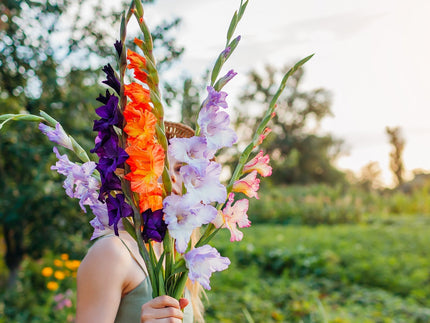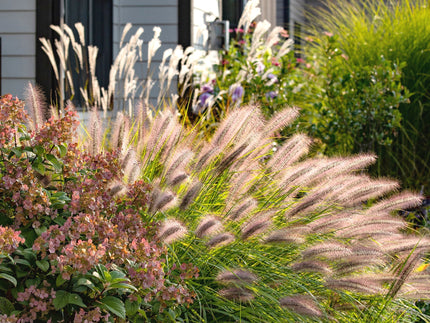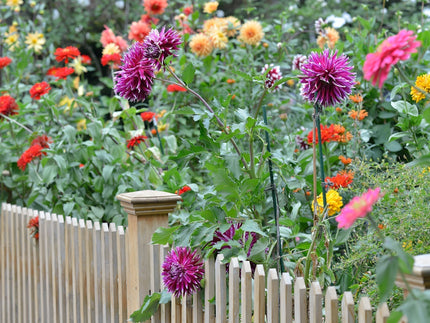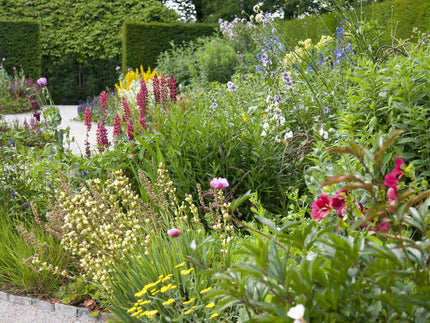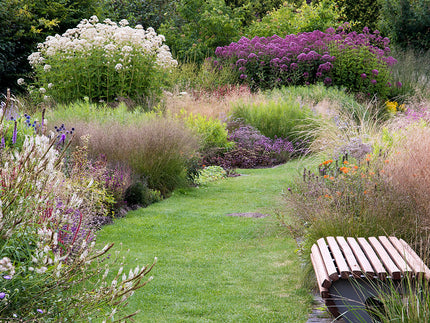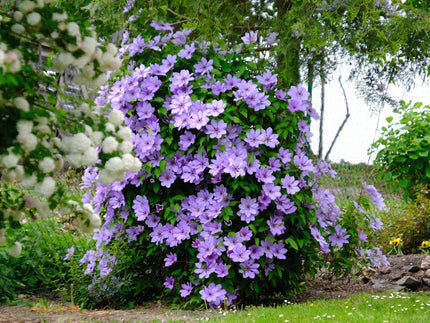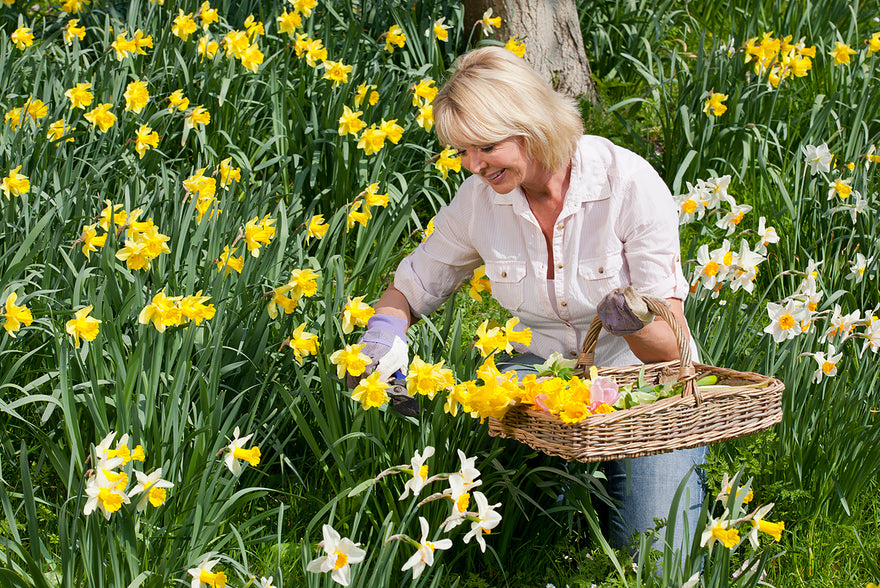
All you need to know about daffodils and narcissi
Daffodils are one of the most iconic spring bulbs, and many varieties are among the first bulbs to appear in the spring. Instantly recognisable, their cheery blooms herald the promise of warmer weather and longer days as they bask in the gentle spring sunshine.
The radiant trumpet flowers of traditional varieties, such as Narcissus 'Dutch Master', may be the first to come to mind, but did you know that there are over 40 different species and thousands of cultivars and varieties? Daffodils, botanically known as Narcissus, come in a surprising range of colours—yellow, white, cream, there are even some featuring pink and apricot shades.
There are various flower shapes to choose from too. Some are fully double and packed with petals, others are traditional with a single ring of petals and a trumpet in the middle. There are many varieties which produce multiple blooms on one stem, and others with a single flower stem. Some varieties are dainty and small, whilst others are big and chunky.

Unlike many spring bulb types, narcissus varieties flower at different points during spring. There are early varieties, like Narcissus 'Tête à Tête' and Narcissus 'Jetfire', which make an enthusiastic start in February or March. There are varieties which bloom in mid-spring, joining in at the peak of spring flowering season. There are a few varieties, such as Narcissus 'New Baby', which start flowering in May—that's very late for a daffodil! Some narcissus varieties can be forced indoors and will flower in your home during winter, filling the room with fragrance.
The fact that daffodils of various types can be seen in flower throughout most of spring, perhaps is the reason that they are one of the best known and most widely recognised of all the spring flowers. If you pick a selection of different varieties, you can enjoy a successive display of daffodils from late winter right through to the end of spring!
Narcissus general info
Daffodils are perennial bulbs which means that they will keep growing back every year. The bulbs will multiply under the soil, forming established clumps over time. They can also be pollinated by insects and set seed, which will eventually grow into flowering bulbs too. With two ways of multiplying, they can naturalise freely and satisfyingly quickly.
Most narcissus species originate from Southern Europe and North Africa. Over the years, these wild daffodils have been cultivated and breeders in Europe have produced some exceptional new cultivars. There is also a British native daffodil, this is the wild Narcissus pseudonarcissus. This rare, wild British daffodil graces woodlands and meadows in parts of Gloucestershire.

Daffodils have been a popular plant to grow for centuries. This may be down to their undemanding nature, reliable spring colour and repeat show which just keeps getting better every year—there are virtually no downsides to growing them. These hardy, unfussy bulbs will happily pop up in most locations—in lawns, borders, containers, rockeries, woodland areas and even wind-battered coastlines.
Narcissus divisions
With so many varieties available, you will often see them categorised botanically into 13 separate divisions. These divisions are based on their flowering characteristics, grouping similar types neatly together.
In botanical terms, the trumpet of the narcissus is referred to as the corona, while the outer petals are called tepals. Each division has their own characteristics. You don't need to know which division you are growing in order to get a great display from your Narcissus, but it is interesting to know.
Division 1 — Trumpet daffodils
One flower per stem, and each with a trumpet which is at least the same length as each tepal.

Division 2 — Large-cupped daffodils
One flower per stem, each with a corona that is more than one-third, but less than equal to the length of the tepals.

Division 3 — Small-cupped daffodils
One single flower per stem, each with a corona that measures one-third the length of the tepals, or less.

Division 4 — Double daffodils
One or more flowers per stem, with double tepals or a double corona, or both.

Division 5 — Triandrus narcissus
Two or more flowers per stem with reflexed tepals.

Division 6 — Cyclamineus narcissus
One single flower per stem, with reflexed tepals and a short neck holding the bloom at a steeply acute angle to the stem.

Division 7 — Jonquilla and apodanthus narcissus
Between one and five, or occasionally up to eight flowers per stem. Flowers are acutely angled to the stem with a corona that is cup, funnel or flared in shape, and usually wider than it is long. Tepals are spreading or reflexed and the blooms are usually fragrant.

Division 8 — Tazetta narcissus
Between three and twenty flowers per stem with spreading tepals. Stems are stout and blooms are usually fragrant.
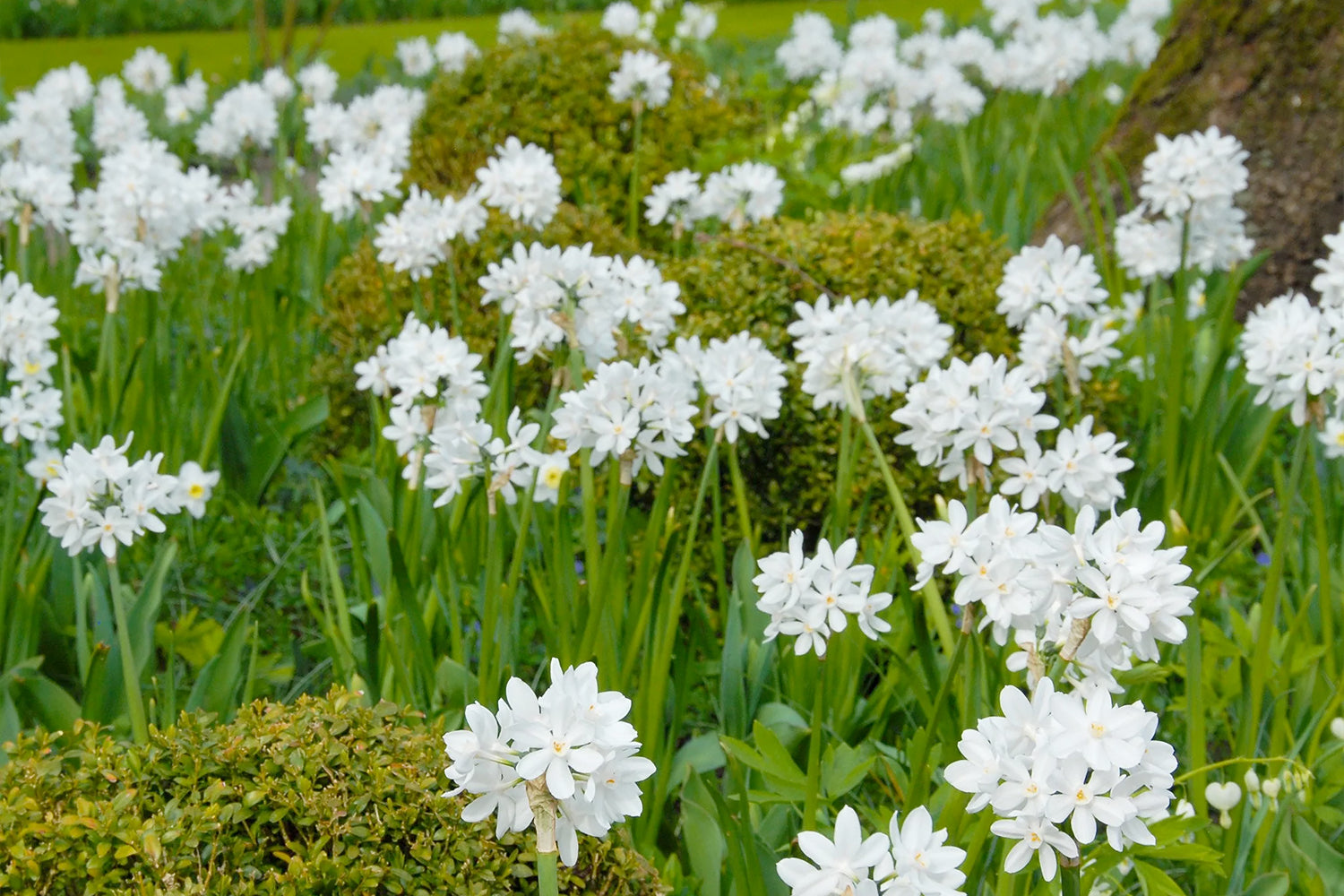
Division 9 — Poeticus narcissus
Usually one flower per stem. Corona is very short or disc-shaped, usually with a green/yellow centre and red rim. Tepals are white and flowers are usually fragrant.

Division 10 — Narcissus bulbocodium
Normally a single flower per stem with tepals which are insignificant compared to corona, and with anthers which have a curved filament and style.

Division 11 — Split-corona daffodil
Corona is split, usually for more than half of its length.
- Collar daffodils — Corona segments are opposite the tepal segments, usually in two whorls of three.
- Papillon daffodils — Corona segments are alternate to the tepal segments, usually in one whorl of six.
Division 12 — Other daffodil cultivars
Daffodil cultivars which do not fit the definition of any other division.
Division 13 — Daffodils distinguished solely by botanical name
Wild (species) daffodils and hybrids without cultivar names (e.g. Narcissus pseudonarcissus)
When your narcissus bulbs arrive…
Daffodils are supplied as dormant bulbs from September through to early December. They are best planted when you receive them and should certainly be planted by the end of the year as they will naturally begin to deteriorate after this time if they remain unplanted.

Check the condition of your daffodil bulbs when they arrive. They should feel firm with a dry, papery skin, and no soft or mushy areas. If you need to store them for a short while before planting, simply open the bags to improve ventilation and keep them in a cool, dry, airy and frost-free location. They can usually remain fresh in storage until around mid December, but planting sooner rather than later is preferred.
Where to plant daffodils
Narcissus aren't terribly fussy, but they will prefer a fertile and moist but well drained soil. Avoid soggy, waterlogged soils or very dry conditions. If your soil is clay and rather heavy, or particularly gritty, the addition of some well-rotted garden compost or manure will help to improve the soil texture. You can dig this into the soil before planting.
A few varieties, such as Narcissus 'Pheasant's Eye', can cope with shade, but the vast majority of Daffodils will prefer full sun, part shade or dappled shade.
Small daffodil varieties are a great choice for rockeries, small pots, edging beds and borders or planting in lawns. If you're planting daffodils in the lawn, it's a good idea to plant in neat clumps as this makes it easier to mow around them in spring. Alternatively, you can choose early flowering varieties, like Narcissus 'Tête à Tête' which have usually finished flowering by the time the lawn needs its first cut later in the spring. Taller varieties can be naturalised in longer grass, woven through borders among perennials, or grown in rows on the allotment for cut flowers.
All varieties can be planted in containers. Use miniature cultivars for window boxes, while taller varieties can be planted in larger containers alongside your favourite tulips or other spring-flowering bulbs to create a fabulous mixed pot combination. For indoor displays, choose varieties listed as suitable for indoor growing. Narcissus tazetta 'Paperwhite Ziva' is fast growing indoors and blooms in the middle of winter without the need for any cold period.
How to plant Narcissus bulbs
Plant Narcissus bulbs at a depth of roughly three times the height of the bulb. Always ensure that the pointed end faces upwards towards the soil surface. In borders or grass, the bulbs should be planted at a distance of roughly twice their width apart. This will give them space to naturalise in future years as the bulbs will gradually increase in numbers.

In containers you can plant daffodil bulbs closer to create a denser, more luxurious display. They can be transplanted into the garden in future years so they won't mind being a little crowded for one season. You can experiment with planting containers and borders with a range of Narcissus varieties which have different flowering periods to create a longer lasting display!
Spacing daffodils
Daffodils are so lovely and unfussy that it's not usually too much of a problem if you order a few more than you'll need. Surplus bulbs can always be dotted around the garden in any space available.
How many you'll need depends on the size of the variety. Tall daffodil varieties tend to grow from large bulbs and can be planted in groups or drifts at a spacing of around 10-15cm in borders or through grass. Dwarf daffodil varieties grow from smaller bulbs and can be planted at a spacing of around 5-10cm apart from each other. In containers, all daffodil types can be packed in a little closer to avoid a sparse-looking pot. Allowing a spacing of 5cm apart in pots for both large and small varieties will look good in bloom the following spring. As daffodils multiply, they will appreciate being separated or planted out into the garden after 1-2 years if planted this close.

If you're planning on filling some large spaces in borders with daffodils, it is useful to know roughly how many you'll need per metre square. For large varieties, we recommend using around 60 bulbs per metre square, or around 75 bulbs for small varieties. This number of bulbs will create an impact in the first year, and allow space for the bulbs to multiply in future years.
Growing narcissi indoors
You can enjoy the colour and perfume of narcissi in your home by forcing them into growth in winter. It's easy to do but requires a little planning ahead for some varieties.
Choose varieties which are suitable for indoors growing, such as Narcissus 'Grand Soleil d'Or', 'Avalanche', 'Erlicheer' or paperwhites.
Apart from the paperwhites (which need no cold treatment), the above varieties can be forced to flower early by potting them up in September and keeping them outdoors in a cool position first. They should have enough of a cold season by around mid-December, and at that point can be moved indoors. The temperature change will trigger them into early growth and they will flower indoors during winter.
Paperwhites, on the other hand, are ready to grow straight away. They can be planted indoors with no cold period and will start to grow fairly rapidly. It usually takes them between 4-8 weeks to reach a flowering stage.

You can plant the bulbs in a pot of compost or fill a cylindrical vase with gravel or pebbles. Push each bulb slightly into the surface of the compost and add some water. For vases, add just enough water so that the base of the bulb is at the waterline but not submerged. Position the pot or vase on a warm, bright windowsill and wait for the magic to begin!
For more information on forcing Narcissus tazetta 'Paperwhite Ziva' bulbs indoors, take a look at our helpful Planting Paperwhites video.
Daffodil aftercare
Daffodils are incredibly self-sufficient and don't demand much care at all. Once planted, they can be left in the soil to their own devices all year round. There are a few things which you can bear in mind:
Watering daffodils
Water lightly after planting to settle the soil around the bulbs. They won't require any water over winter.
Containers or pots are prone to drying out during a warm spring, therefore daffodils which are growing in containers may need a little watering during spring if the soil looks completely dried out. Daffodils growing in borders or lawns don't usually need watering during spring because the roots are able to reach moisture at deeper levels in the soil. There's no need to water after the foliage starts to turn yellow in late spring.
Feeding daffodils
Daffodils don't require feed in order to perform well. The bulb itself stores all the nutrients they need to produce good blooms. It is optional, but you can apply a feed in spring when the foliage begins to emerge. A general purpose or home-made comfrey feed will help to replenish the nutrients in the soil.
Deadheading daffodils
If you like to keep things tidy, deadheading faded flowers will make all the difference to your display. It also prevents the bulb from wasting valuable energy on producing unnecessary seedpods.
Simply snip off the faded flower and developing seedpod at the top of each stem. Leave the flower stems and leaves in place though, as these will still continue transfer energy to the bulb. If the stem and foliage is removed or tied into a knot while still green, your daffodils may come up blind (without flowers) next year.

Mowing around clumps in grass
Where bulbs have been naturalised in areas of grass, avoid mowing over the area until the foliage has completely died back—remember that this might not be until late May for later flowering varieties. For this reason, it’s often better to plant the bulbs in clumps throughout lawns rather than dotted randomly. This allows you to mow around the clumps to keep the lawn in check without disturbing the bulbs.
Dormancy, division and relocating daffodil bulbs
Daffodil bulbs become dormant once the leaves have turned yellow or died back. There's no need to lift, feed or water them whilst dormant. They can simply be left in the soil undisturbed throughout the year.
If you wish to relocate daffodil bulbs to free-up a container for summer, you can do so as soon as they have finished flowering. They can be transferred into a different part of the garden straight away, replanted with the leaves and stems intact and then allowed to die back in their new position. It is worth watering them after relocating when still green.
If you want to divide large clumps of bulbs then this should ideally be done once the foliage has turned yellow. You can also do it in autumn (if you had previously marked where your bulbs are!). Carefully lift the clump with a garden fork or spade, taking care not to damage the bulbs. Gently ease away the bulbs that you want to relocate and be sure to plant these as soon as possible. The remainder can be replanted in their original hole.
Daffodil problems and troubleshooting
Narcissus are generally very reliable. If there are any issues, it is usually caused by their growing conditions.
Daffodil blindness
Foliage but no flowers is the most common problem. This is usually caused by the growing environment or removal of leaves and stems whilst still green. If it is caused by conditions, you can rectify the problem, although it may take a year or two before they bloom again,
In areas that are too shaded, simply move the bulbs to a sunny spot between May and October. Soils with poor fertility can be improved by applying a mulch of well-rotted manure or garden compost to improve soil condition and provide much needed nutrients. This can be done in the autumn or early spring before they begin to grow.
Congested, overcrowded bulbs can also suffer daffodil blindness. Divide your bulbs and replant them to give them some extra space.
Planting depth can also affect flowering so it's worth checking that they are planted at the correct depth of roughly 2-3 times the height of the bulb. Lift bulbs in late spring or autumn and amend this if necessary.
Narcissus bulb fly
This pest can be hard to diagnose as the symptoms are similar to daffodil blindness and rotting. However, if you discover the presence of small white maggots within the bulbs themselves then this is likely to be narcissus bulb fly. The larvae eat away the centre of otherwise healthy bulbs leaving behind a mushy brown mess.

Our bulbs are regularly inspected for pests and diseases by the Dutch and British plant health authorities, which avoids that risk.
No show of bulbs—rotting
Narcissus can tolerate short periods of wet soil, but if these conditions persist then fungal infections such as basal rot can set in, turning the bulb to mush. Avoid planting in soils which are prone to waterlogging, and always ensure that containers have drainage holes to allow excess water to escape. Be particularly mindful of this when growing bulbs in vases and pots indoors. The bulbs should sit just above the water line and never directly in water.
Narcissus bulbs emerging early
It is normal for many daffodil varieties to start growing shoots in December. With some varieties flowering as early as February, this is just the start of their growth cycle and they will flower in spring as expected. Don't worry about frost or snow damaging the shoots, narcissi are typically fully hardy to around -20°C.
































































































































































































